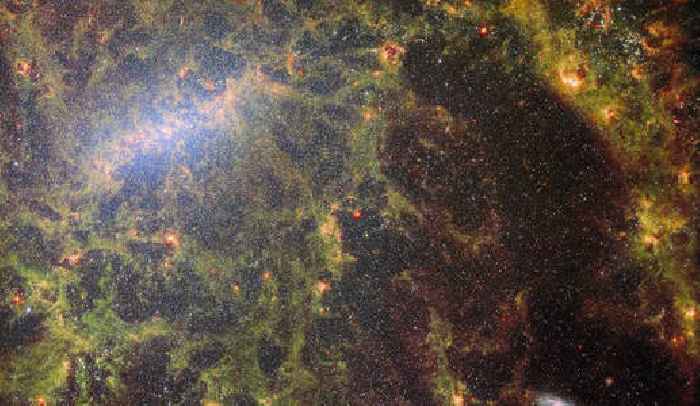Image:
A delicate tracery of dust and bright star clusters threads across this image from the NASA/ESA/CSA James Webb Space Telescope. The bright tendrils of gas and stars belong to the barred spiral galaxy NGC 5068, whose bright central bar is visible in the upper left of this image. NGC 5068 lies around 17 million light-years from Earth in the constellation Virgo.
This portrait of NGC 5068 is part of a campaign to create an astronomical treasure trove, a repository of observations of star formation in nearby galaxies. Previous gems from this collection can be seen here and here. These observations are particularly valuable to astronomers for two reasons. The first is because star formation underpins so many fields in astronomy, from the physics of the tenuous plasma that lies between stars to the evolution of entire galaxies. By observing the formation of stars in nearby galaxies, astronomers hope to kick-start major scientific advances with some of the first available data from Webb.
The second reason is that Webb’s observations build on other studies using telescopes including the NASA/ESA Hubble Space Telescope and some of the world’s most capable ground-based observatories. Webb collected images of 19 nearby star-forming galaxies which astronomers could then combine with catalogues from Hubble of 10 000 star clusters, spectroscopic mapping of 20 000 star-forming emission nebulae from the Very Large Telescope (VLT), and observations of 12 000 dark, dense molecular clouds identified by the Atacama Large Millimeter/submillimeter Array (ALMA). These observations span the electromagnetic spectrum and give astronomers an unprecedented opportunity to piece together the minutiae of star formation.
With its ability to peer through the gas and dust enshrouding newborn stars, Webb is the perfect telescope to explore the processes governing star formation. Stars and planetary systems are born amongst swirling clouds of gas and dust that are opaque to observations in visible light, like many from Hubble or the VLT. The keen vision at infrared wavelengths of two of Webb’s instruments — MIRI and NIRCam — allowed astronomers to see right through the gargantuan clouds of dust in NGC 5068 and capture the processes of star formation as they happened. This image combines the capabilities of these two instruments, providing a truly unique look at the composition of NGC 5068.
NGC 5068 MIRI image
NGC 5068 NIRCam image
[Image description: A close-in image of a spiral galaxy, showing its core and part of a spiral arm. Thousands upon thousands of tiny stars that make it up can be seen, most dense in a whitish bar that forms its core. Clumps and filaments of dust form an almost skeletal structure that follows the twist of the galaxy and its spiral arm. Large, glowing bubbles of red gas are hidden in the dust.]
Webb peers behind bars
ESA
0 shares
1 views


